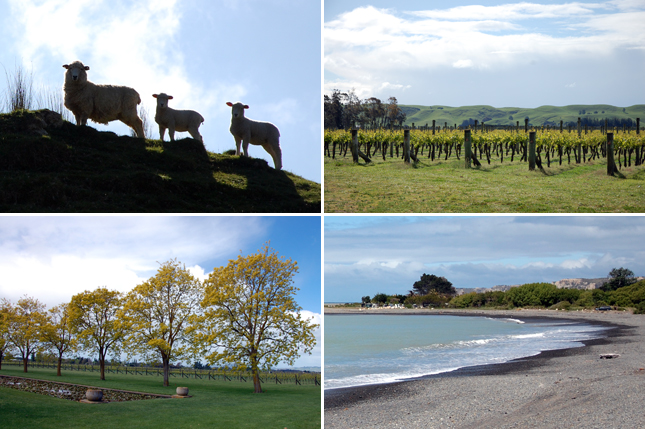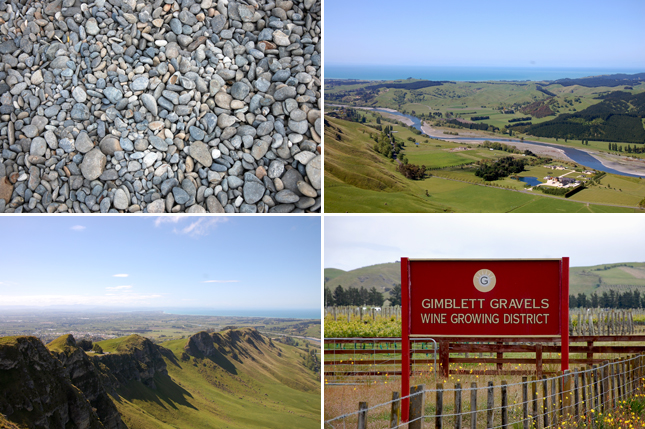Hawke's Bay, New Zealand Competes with Bordeaux

If you were standing on the shore of Cape Kidnappers on 1 January 2000, you would have been among those to see the first sunrise of the new millennium. This distinction was supposed to have belonged to those shoreside in Gisborne, a town 215 kms / 133 mi to the north, but Gisborne and other more easterly points were under clouds. Instead it was the land area called Te Awanga where crowds said to be in the thousands, gathered to watch the dawning of a new era. This portentous event could be seen as the beginning of the ascendancy of the Hawke's Bay wine region.
The region can hardly be understood as a single, distinctive growing area. There are too may differing soils, usually from lot to lot, and complex microclimates. The majority of the area is the flat costal region called the Heretaunga Plains that extend from Napier in the north, south to Te Mata Peak or the Craggy Range and the inland area known as the Gimblett Gravels. A total of 4,923 ha / 12,164 acres of land is used for winemaking in Hawke’s Bay accounting for about 16% of the New Zealand national total. Seemingly anything grows here though Bordeaux style reds have been the region’s long suit. A lot of this has to do with climate. Annually, Hawke’s Bay receives more warmth than Coonawarra and Napa but less than Medoc.
There is plenty of other wine being made in Hawke’s Bay, lots of Chardonnay, a fair amount of Sauvignon Blanc and Gewurztraminer, and an increasing amount of Pinot Noir. Such a variety of grapes might suggest a certain wine making schizophrenia but it is not the case. The geographic diversity and climate of Hawke’s Bay is just that remarkable.
The coastal area of Te Awanga is home to award-winning wineries Clearview Estate and Beach House and the new Elephant Hill. A bit further in, around the Craggy Range is where one will find many of New Zealand’s top-end, state-of-the-art wineries. Places like Craggy Range, Black Barn, Te Mata, Ngatarawa and Askerne. There is something reminiscent of the Napa Valley in this part of Hawke’s Bay. Many of the facilities are ultra-modern and not without a certain kind of NV flash. (Think of places like Quintessa.)
Moving inland to the Gimblett Gravels the entire mood changes.

Before being planted with vines in the ’70’s the Gimblett Gravels seemed to be unfit for anything. Attempts were made to sell the land for housing development but those failed. Other ideas for the area included the construction of warehouses. For awhile there was a drag strip and longer still, a rubbish dump. The only company willing to take a risk on the desolate, wind-bitten area was a concrete interest that bought 150 ha / 370 acres to mine for gravel.
By the 70‘s the two most planted varieties in New Zealand, Chenin Blanc and Müller-Thurgau, were planted in the Gravels by bulk wine makers. The juice from these vineyards was made into the extremely sweet, utterly forgettable wines so popular at the time. Finally, in the ’80’s a pilot turned wine maker, Chris Pask of CJ Pask Winery, came to believe that there might be a use for that desolate, dusty plain off Omahu Road. Pask bought a 40 ha / 98 acre lot, planted the main red Bordeaux grapes then crossed his fingers. Within the decade Pask’s decision to plant in the Gravels was no longer seen as foolhardy but prescient.
How the Gimblett Gravels came to be recognized as one of the world’s preeminent growing regions is as much a result of good marketing as it is of exceptional geology and some meteorological mayhem -- in this case heavy rains and a flood.
Soils similar to those found in the Gimblett Gravels can be found in the Sablet and Séguret communes in France, large portions of the Walla Walla, Washington wine region and Warren/Nyngan areas in New South Wales, Australia. Each of these places shares dried river beds. In the Gimblett Gravels a powerful flood in 1876 changed the course of the Ngaruroro River exposing fast draining gravel with layers of sand, silt and clay further down.
The rocky composition of this dried riverbed is said to impart a “minerality” to the wines of the Gimblett Gravels. The same sort of effect is said to be evident in the wines from Chablis, in German wines made from grapes grown in slate along the banks of the Mosel River, in Blanc de Blancs that come from the chalky hills of Champagne, in the Sicilian reds grown on the slopes of Mount Vesuvius, and of course, the the most famous riverbed wine region of the all: The Bordeaux situated along the Gironde estuary.
Some have called the Gimblett Gravels an “Antipodean Bordeaux,” since it shares more than just similar soil. Though a touch cooler than the Medoc, the Gimblett Gravels/Hawke’s Bay has about the same amount of annual sunshine and both areas benefit (or suffer) from their proximity to the ocean. Like Bordeaux, Hawke’s Bay faces the same late-season threats of rain and hail, though one can add the periodic tropical cyclone to the Antipodean Bordeaux’s list of worries.
When conditions are favorable Hawke’s Bay produces world-class wines, as a London tasting held in February of 2009 will attest. At the tasting some of the UK’s most respected wine authorities, among them Jancis Robinson, Oz Clarke and Michael Schuster, conducted a double-blind tasting of six 2005 Bordeaux clarets (a very successful vintage in Bordeaux) alongside six 2005 and 2006 Gimblett Gravels blends. The event was staged as a bit of a “do-over” from a similar tasting held earlier with such wine luminaries as James Halliday and Robert Parker Jr. The outcome at the first tasting looked like this:
1. Blake Family Vineyards “Redd Gravels” Gimblett Gravels, Hawke’s Bay, NZ
2. Chateau Lafite-Rothschild Pauillac, Bordeaux, France
3. Sacred Hill “Helmsman” Gimblett Gravels, Hawke’s Bay, NZ
4. Mills Reef “Elspeth” Cabernet Sauvignon, Gimblett Gravels, Hawke’s Bay, NZ
5. Chateau Mouton-Rothschild Pauillac, Bordeaux, France
6. Trinity Hill “The Gimblett” Gimblett Gravels, Hawke’s Bay, NZ
The results of the re-do looked like this:
1. Chateau Lafite-Rothschild, Pauillac, Bordeaux, France
2. Chateau Mouton-Rothschild, Pauillac, Bordeaux, France
3. Chateau Angelus, St Emilion, France
4. Sacred Hill – The Helmsman, Gimblett Gravels, Hawke's Bay, NZ
5. Chateau Haut-Brion, St Estephe, Bordeaux, France
6. Newton/Forrest Cornerstone, Gimblett Gravels, Hawke's Bay, NZ
Again, the Kiwi wines stood shoulder-to-shoulder with the Bordeaux powerhouses. Another surprise was that the French wines in the tasting sell for an average £650/US$1,080 while the New Zealand wines run about £18/US$30. At the conclusion of the tasting wine maven Jancis Robinson commented, “I think this [the Hawke’s Bay wines] is the closest to Bordeaux you can get.”
The region is also well-known for golf. If you’re looking for lodging for next years Kiwi Challenge at Cape Kidnappers might we suggest Cape Kidnapper’s Lodge.
For dining Elephant Hill and Black Barn are tops.
Also see Berry Bros & Rudd’s Hawke’s Bay Wine map.






 Share Article
Share Article
Reader Comments (10)
twenty thumbs up!! well done...did you take those photos?? fantastic !!!!
The photos are beautiful. I was there years ago. Thanks for the memories.
LL
Love all the beautiful photos. I have always wanted to move to New Zealand. Looking at these photos only make me want to move there all the more. Thanks for sharing.
Amazing photos and great write up! I feel like I'm learning so much about wine through your posts!!
I spent one whole year staying at N.Z. back in year 1999 but had never been to Hawke's Bay. I was in Wellington and also been to South Island. N.Z. is such a beautiful place. I definitely will go back there again if I've the chance. Cheers.
Great story, great pics!
I have a slightly different take on Gimblett Gravels: It looks to me more like Chateauneuf du Pape than anything else--within minutes of arrival at Hatton Estate, I was referring to the profusion of rocks as "galets." Michael Hatton and a bunch of other producers in the GG district have planted syrah, producing wines with definite Rhone-like qualities. Here's a link to the Gimblett Gravels Grower/Producer association; many of them are syrah specialists.
Dear Wine Mule,
Without a doubt there are the same nice sized rocks in Gimblett that you also find in the southern Rhone. On the way to one of the wineries in the Gimblett Gravels we passed a recently tilled field and saw the same "galates." (This field was right near Hatton Estate.Still ticked we couldn't make a visit to Hatton Estate, it was highly recommended to us and we really wanted to go.) The presence of these heat holding stones may or may not play a part in the success of Syrah in the Gimblett Gravels equation. Then there's the "infertility" of the riverbed soils that lend themselves nicely to Cab, Merlot, Cab Franc, etc. and evidently Tempranillo. From these same soils one of the 2009 Air New Zealand award winners came: the Trinity Hills Tempranillo. The producers in all of Hawke's Bay seem pretty confident that they can get a handle on most any kind of grape. Maybe they' re right. Time will tell.
Tempranillo? Why not. Hey, what do you bet somebody there is fooling with malbec?
After having lived in NZ since 1998, and witnessed the rise of Gimblett Gravels and Hawke's Bay as a wine region, I think the account is very accurate and well written.
My only concern with Gimblett Gravels as a wine region is its reliance on irrigation for the vines to survive year on year. Their are other regions, as mentioned, that do not rely so heavily on irrigation and the terroir sings through.
The wines from Hawke's Bay are good but lack a little character and seem too polished compared to wines of France.
There are some wines that I would mention as being more terroir driven without winning awards and they are Hatton Estate, Ashridge, and Wishart Estate.
--Hey Jason,
We really wanted to taste Hatton while we were there but they were closed. We agree that the wines here are very toned-down compared to some of our favorite regions but we did not notice a reliance on irrigation. This region is much more humid, in fact one of their problems is clay soil and semi-tropical rains. We are from California where the problem is the exact opposite so perhaps our perspectives are skewed. While we have our own opinions on the wines of the GG we left them out of this article, as we do most.
Cheers,
Amber & Kevin